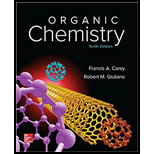
Interpretation:
The structure for compound X is to be determined in the given fragmentation-recombination process of
Concept introduction:
are represented by a Lewis structure such that four electrons
are delocalized over three atoms. One of them is positively charged while the other is negatively charged. The positively charged carbon atom remains unchanged.
The alkene is the
electron component.
This dipole acts as a
electron component via the
The second step in the mechanism of ozonolysis of alkenes undergoes a fragmentation-recombination process.
The fragmentation step is the reverse of a
cycloaddition step.
The fragmentation of ozonide yields a carbonyl compound and a
compound.
The carbonyl compound and
compound react again to give a product via
cycloaddition.
For an unsymmetrical
electron component, the two ends of the double bond constitute two possible sites of reaction.
In the fragmentation process, the single bond between two carbon atoms attached to the oxygen atoms in the ozonide breaks.
Want to see the full answer?
Check out a sample textbook solution
Chapter 11 Solutions
ORGANIC CHEMISTRY (LOOSELEAF)-PACKAGE
- K Draw the starting structure that would lead to the major product shown under the provided conditions. Drawing 1. NaNH2 2. PhCH2Br 4 57°F Sunny Q Searcharrow_forward7 Draw the starting alkyl bromide that would produce this alkyne under these conditions. F Drawing 1. NaNH2, A 2. H3O+ £ 4 Temps to rise Tomorrow Q Search H2arrow_forward7 Comment on the general features of the predicted (extremely simplified) ¹H- NMR spectrum of lycopene that is provided below. 00 6 57 PPM 3 2 1 0arrow_forward
 Organic ChemistryChemistryISBN:9781305580350Author:William H. Brown, Brent L. Iverson, Eric Anslyn, Christopher S. FootePublisher:Cengage Learning
Organic ChemistryChemistryISBN:9781305580350Author:William H. Brown, Brent L. Iverson, Eric Anslyn, Christopher S. FootePublisher:Cengage Learning
